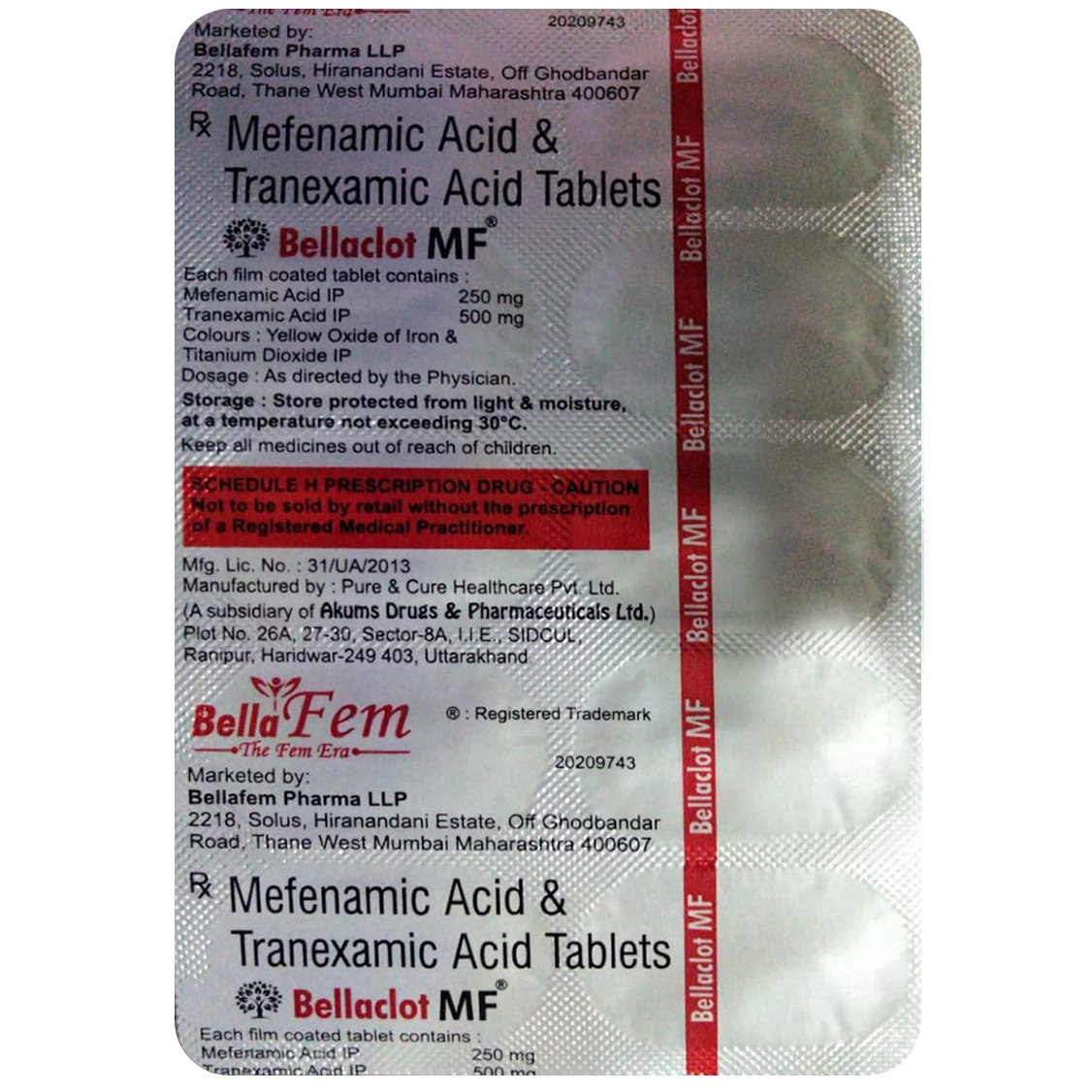Tranexamic Acid+mefenamic Acid
About Tranexamic Acid+mefenamic Acid
Mefenamic Acid+tranexamic Acid is used to treat dysmenorrhea (period pain) and menorrhagia (heavy menstrual bleeding). Menstrual cramps, also known as dysmenorrhea, are characterized by cramps and pain during menstruation. Menorrhagia is a condition with abnormally heavy or prolonged bleeding during menstruation/periods.
Mefenamic Acid+tranexamic Acid is a combination of Tranexamic acid and Mefenamic acid. Tranexamic acid helps the body's natural blood clotting process by preventing fibrin breakdown, which stops blood clot formation. Mefenamic acid works by blocking the effect of chemical messengers that cause pain.
In some cases, you may experience certain common side effects such as nausea, vomiting, diarrhoea, indigestion, heartburn, and headache. Most of these side effects do not require medical attention. However, talk to your doctor if you experience these side effects persistently.
You are advised to take Mefenamic Acid+tranexamic Acid for as long as your doctor has prescribed it for you, depending on your medical condition. Mefenamic Acid+tranexamic Acid can be taken with or without food. Do not crush, chew, or break it.
Avoid taking Mefenamic Acid+tranexamic Acid if you are allergic to it. Consult your doctor if you are pregnant or breastfeeding. Mefenamic Acid+tranexamic Acid may cause dizziness, so drive with caution. Mefenamic Acid+tranexamic Acid should not be given to children as safety and efficacy have not been established.
Uses of Tranexamic Acid+mefenamic Acid
• Management of Menstrual Disorders: Mefenamic Acid+tranexamic Acid is used to help regulate menstrual cycles in women experiencing irregular periods or hormonal imbalances.
• Relief from Menopausal Symptoms: Mefenamic Acid+tranexamic Acid can alleviate symptoms associated with menopause, such as hot flashes and mood swings.
• PMS Symptom Relief: Mefenamic Acid+tranexamic Acid is effective in minimising premenstrual syndrome (PMS) symptoms, including cramps, anxiety, and other mood-related issues associated with the menstrual cycle.
Medicinal Benefits
- Mefenamic Acid+tranexamic Acid is used to treat abdominal pain, dysmenorrhea (period pain), and menorrhagia (heavy menstrual bleeding).
- Additionally, Mefenamic Acid+tranexamic Acid is also used to treat severe blood loss, swelling in various body parts, fever, inflammation, and migraine headache.
- Mefenamic Acid+tranexamic Acid is a combination of two drugs, namely: Tranexamic acid and Mefenamic acid.
- Tranexamic acid is an anti-fibrinolytic agent that helps the body's natural blood clot process by preventing fibrin's breakdown, this stops fibrinolysis, a process that stops blood clot formation.
- Mefenamic acid is an NSAID that works by blocking the effect of a chemical messenger in the body, known as cyclo-oxygenase (COX) enzymes that make other chemical prostaglandins.
- By blocking the COX enzyme's effect, lesser prostaglandins are produced, which reduces mild to moderate pain and inflammation at the injured or damaged site.
Directions for Use
- Mefenamic Acid+tranexamic Acid can be taken with or without food.
- Adhere to your doctor's guidance regarding the dosage and timing of this medication for optimal effectiveness.
- Swallow Mefenamic Acid+tranexamic Acid as a whole with a glass of water.
- Do not crush, chew, or break it.
Storage
Side Effects of Tranexamic Acid+mefenamic Acid
- Nausea
- Vomiting
- Diarrhea
- Indigestion
- Heartburn
- Headache
- Musculoskeletal pain
- Stomach pain
Drug Warnings
- Do not take Mefenamic Acid+tranexamic Acid if you are allergic to any of its contents or if you have severe heart failure.
- Inform your doctor if you have/had deep vein thrombosis, pulmonary embolism (blockage of a blood vessel in the lungs), coagulopathy (formation of blood clots), epilepsy, irregular periods, heart, kidney, or liver problems.
- Consult your doctor if you are pregnant or breastfeeding.
- Mefenamic Acid+tranexamic Acid may cause dizziness and drowsiness, so drive only if you are alert.
- Mefenamic Acid+tranexamic Acid should not be given to children as safety and effectiveness have not been established.
- Avoid consuming alcohol along with Mefenamic Acid+tranexamic Acid as it could lead to increased drowsiness and can increase the risk of stomach bleeding.
- Do not take any other NSAIDs for pain relief along with Mefenamic Acid+tranexamic Acid unless prescribed.
Drug Interactions
Drug-Drug Interactions: Mefenamic Acid+tranexamic Acid may interact with pain killers (ibuprofen, celecoxib), anti-depressants (duloxetine, fluoxetine, sertraline), fibrinolytic medicine, birth control pills, drugs that prevent bleeding (factor IX complex, anti-inhibitor coagulant concentrates), blood thinners (anticoagulants such as warfarin, heparin)
Drug-Food Interactions: No interactions found/established.
Drug-Disease Interactions: Inform your doctor if you have deep vein thrombosis, pulmonary embolism (blockage of blood vessels in the lungs), coagulopathy (formation of blood clots), epilepsy, peptic ulcers, asthma, glaucoma, gastrointestinal toxicity, high blood pressure, or heart problems.
Drug-Drug Interactions Checker List:
Safety Advice

Alcohol
unsafeAvoid consumption of alcohol while taking Mefenamic Acid+tranexamic Acid as it may cause increased drowsiness. It can also increase the risk of stomach bleeding.

Pregnancy
consult your doctorPlease consult your doctor if you are pregnant or if you have any concerns regarding this; your doctor will prescribe only if the benefits outweigh the risks.

Breast Feeding
consult your doctorConsult your doctor before taking Mefenamic Acid+tranexamic Acid if you are breastfeeding, your doctor will decide if Mefenamic Acid+tranexamic Acid can be taken by breastfeeding mothers or not.

Driving
unsafeMefenamic Acid+tranexamic Acid may cause drowsiness and dizziness. Do not drive or operate machinery unless you are alert.

Liver
consult your doctorPlease consult your doctor if you have a liver impairment or any concerns regarding this.

Kidney
consult your doctorPlease consult your doctor if you have kidney impairment or any concerns regarding this.

Children
unsafeMefenamic Acid+tranexamic Acid should not be given to children as the safety and effectiveness were not established.
Habit Forming
Diet & Lifestyle Advise
- Follow a healthy diet. Include vegetables, fruits, and whole grains in your meals.
- Stay hydrated; drink plenty of water.
- Cut down on sugars, salts, spicy food, coffee, and alcohol.
- A heating pad can help ease the pain by placing it on the belly or lower back.
- Exercise can help ease the pain of menstrual cramps.
- Avoid stress by performing meditation or yoga.
- Massage your lower back or abdomen to relieve the pain.
- Take proper rest.
Patients Concern
Disease/Condition Glossary
Menorrhagia: Menorrhagia is a condition with abnormally heavy or prolonged bleeding during menstruation/periods. The exact cause of menorrhagia is unknown, but it could be due to hormonal imbalance, dysfunction of the ovaries, uterine fibroids, polyps, inherited bleeding disorders, intrauterine devices, or medications. Symptoms include soaking through one/more sanitary pads/tampons for every hour, needing to use double sanitary protection to control the flow, needing to wake up during the night to change the pad, bleeding for more than a week, passing blood clots, being unable to do daily activities due to heavy flow, tiredness, and fatigue.
Dysmenorrhea: Menstrual cramps, also known as dysmenorrhea, are characterised by cramps and pain during menstruation due to heavy flow. Pain, cramps, and discomfort during periods are normal. However, excessive pain during periods is not normal and requires medication. Symptoms of dysmenorrhea include intense throbbing pain in the lower abdomen, dull, continuous aches, pain in the lower back and thighs, nausea, headache, and dizziness. The pain usually starts 1-3 days prior to the period, peaks one day before the period starts, and subsides 2-3days after the onset of the period.
FAQs
Mefenamic Acid+tranexamic Acid is used to treat dysmenorrhea (period pain) and menorrhagia (heavy menstrual bleeding). Besides this, it is also used to treat severe blood loss, swelling in various body parts, fever, inflammation, and migraine headache.
Mefenamic Acid+tranexamic Acid contains Tranexamic acid and Mefenamic acid. Tranexamic acid helps the body's natural blood clot process by preventing the breakdown of fibrin, this stops fibrinolysis, a process that stops blood clot formation. Mefenamic acid works by blocking the effect of chemical messengers that cause pain.
Diarrhea might be a side-effect of Mefenamic Acid+tranexamic Acid. Drink enough fluids and eat non-spicy food if you experience diarrhea. Consult your doctor if you experience severe diarrhea or if you find blood in stools.
Mefenamic Acid+tranexamic Acid should not be taken for longer durations unless prescribed by the doctor. Mefenamic Acid+tranexamic Acid is usually prescribed for a few days at the time of heavy bleeding and cramps.
Mefenamic Acid+tranexamic Acid is used to treat dysmenorrhea (period pain), pain due to heavy bleeding during periods, and menstrual cramps. Take Mefenamic Acid+tranexamic Acid only as prescribed and do not overdose.
Consult your doctor before taking contraceptive pills along with Mefenamic Acid+tranexamic Acid. When taken together, there is an increased risk of deep vein thrombosis (blood clot in the deep vein, usually in the legs).
Mefenamic Acid+tranexamic Acid contains mefenamic acid, an NSAID which might increase the risk of cardiovascular thrombotic events, myocardial infarction, and stroke. Therefore, avoid taking Mefenamic Acid+tranexamic Acid if you have heart-related problems unless prescribed by the doctor.
Mefenamic Acid+tranexamic Acid typically starts to show its effects within 1-2 hours of taking it, and it helps to reduce heavy menstrual bleeding by improving blood clotting but does not stop bleeding. However, the exact duration for bleeding to stop can vary from one person to other.
Yes, Mefenamic Acid+tranexamic Acid can cause acidity. If you experience heartburn and indigestion, it's advisable to take Mefenamic Acid+tranexamic Acid with food to minimize discomfort. If the symptoms persist, please consult your doctor.
Yes, Mefenamic Acid+tranexamic Acid is safe if you take as per the dose and duration prescribed by your doctor. However, it's important to be aware of potential side effects and contraindications. Always consult your doctor before starting any new medication to ensure it is safe for you, especially if you have pre-existing conditions or are taking other medications.
Always follow your doctor's instructions regarding dosage and duration. Usually it is prescribed for a short duration. Do not exceed the prescribed duration. As overuse can lead to side effects and other health issues.
Mefenamic Acid+tranexamic Acid is a combination of two drugs, tranexamic acid (anti-fibrinolytic) and mefenamic acid (NSAID).
Yes, do not take Mefenamic Acid+tranexamic Acid if you are allergic to any of its contents or if you have severe heart failure. Inform your doctor if you have/had deep vein thrombosis, pulmonary embolism (block a blood vessel in the lungs), coagulopathy (formation of blood clots), epilepsy, irregular periods, heart, kidney, or liver problems. Consult your doctor if you are pregnant or breastfeeding. Do not take any other NSAIDs for pain relief along with Mefenamic Acid+tranexamic Acid unless prescribed.
Store Mefenamic Acid+tranexamic Acid at a temperature not exceeding 25°C. Protect it from light and moisture. Keep out of reach of children.
Yes, you can take Mefenamic Acid+tranexamic Acid with food. It is often recommended to take it after a meal to avoid stomach upset or other gastrointestinal side effects.
Please consult your doctor if you are pregnant. Your doctor will prescribes Mefenamic Acid+tranexamic Acid only if the benefits outweigh the risks.
The common side effects of Mefenamic Acid+tranexamic Acid are nausea, vomiting, diarrhea, indigestion, heartburn, and headache. If any of these side effects persist or worsen, please consult your doctor.
You are recommended to consult your doctor before taking other medicines with Mefenamic Acid+tranexamic Acid to avoid possible interactions.



